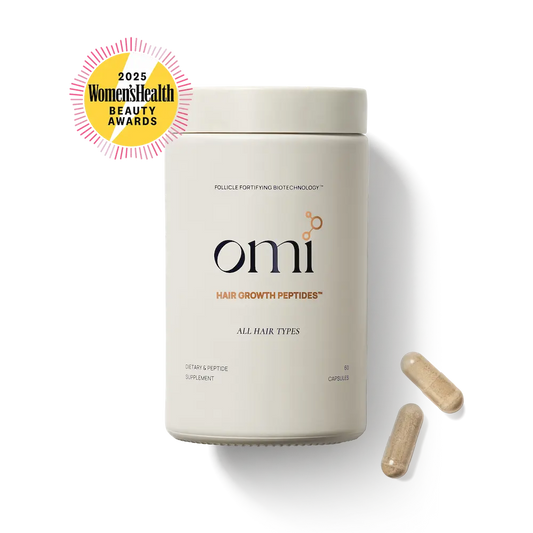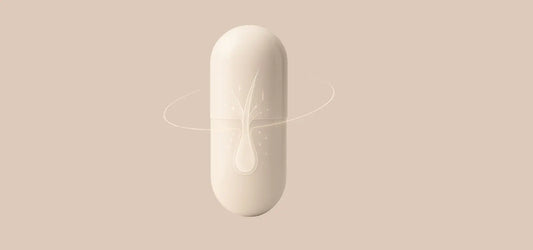The Best Hair Care Tools to Support Healthy Hair Growth

SHOP this article
OMI
Hair Growth Peptides Capsules
Promote stronger hair growth and scalp health with our unique peptide formula.
If you’ve ever paused on content in your social feed related to hair growth products (such as red light devices and scalp massagers) you’re likely being served up even more hair growth tools and tactics—and wondering what actually works. Hair growth is, of course, a complex biological process that depends on the health of your scalp, the activity of your hair follicles, and the nutrients available to them. So while there’s no single miracle device that can instantly regrow hair, modern hair growth products and technologies now make it possible to support this process at home in ways that were once only available in clinics. Devices that improve blood flow, scalp health, stimulate follicles, and enhance product absorption can make a measurable difference when used consistently and correctly.
In this guide, we explore the most effective hair care tools designed to promote healthy hair growth, the scientific mechanisms behind how they work, and how to incorporate them into a realistic hair care routine.
Understanding the Biology of Hair Growth
Each hair strand grows from a follicle located in the dermal layer of the scalp. The follicle operates in a continuous cycle consisting of three key phases: the anagen phase (active growth), the catagen phase (transition), and the telogen phase (resting or shedding). On average, about 85 to 90 percent of scalp hairs are in the growth phase at any given time.
Several factors can disrupt this cycle, including stress, hormonal changes, nutrient deficiencies, and inflammation. Over time, these factors can shorten the anagen phase and lead to thinner, weaker hair. Hair growth peptides and hair care tools that target the scalp can help by increasing blood flow, improving cellular metabolism, and maintaining a clean and balanced environment around the follicle.
Red Light Therapy: Revitalizing Follicles with Energy
Red light therapy, also known as low-level laser therapy (LLLT), is one of the most scientifically supported consumer hair growth tools. It works through a process known as photobiomodulation, which uses red and near-infrared light to influence cell function at the mitochondrial level.
The mitochondria are the energy centers of each cell. When exposed to red light in the 630 to 680 nanometer wavelength range, they absorb photons that increase the production of adenosine triphosphate (ATP), the molecule responsible for energy transfer in cells. This increase in ATP stimulates follicular cells, enhances protein synthesis, and activates stem cells in the hair bulge region, which plays a critical role in initiating new hair growth.
In addition to stimulating cell metabolism, red light therapy increases microcirculation in the scalp. This means more oxygen and nutrients reach the follicles, and waste products are removed more efficiently. Clinical studies have shown measurable results. A 2013 randomized trial found that participants who used a 655 nm laser cap three times a week experienced a significant increase in hair density after 16 weeks. A separate study in the Annals of Dermatology found similar results, with improved hair thickness and follicle activity in both men and women.
When choosing a device, look for one that is FDA-cleared for hair growth use and offers full scalp coverage. Most devices recommend 10 to 30 minutes per session, three to five times per week. Red light therapy is most effective for those in the early to moderate stages of thinning, when follicles are still viable.
Scalp Massage Tools: Improving Circulation and Mechanical Stimulation
A scalp massage may seem simple, but the science behind it is surprisingly robust. Mechanical stimulation of the scalp has been shown to increase dermal blood flow and influence the mechanical stretch of hair follicle cells, both of which can support hair growth and improve scalp health.
When you massage the scalp, you physically stretch the dermal papilla cells, which are specialized cells located at the base of the follicle. This stretching activates genes related to hair cycle regulation, including vascular endothelial growth factor (VEGF), which promotes blood vessel formation and improved nutrient delivery.
A 2016 study published in Eplasty demonstrated scalp massage increases hair thickness. A group of men massaged their scalps for four minutes daily over 24 weeks noticed positive changes due to improved mechanical stimulation and local circulation. A follow-up study with over 300 participants confirmed similar outcomes, with approximately 70 percent reporting thicker hair after several months of consistent massage.
Scalp massage tools enhance this process by making it easier to apply even pressure and cover the entire scalp. Silicone-tipped massagers are ideal because they are gentle on the skin and hair. They can be used with a sulfate free shampoo, leave-in conditioner, or even a hair growth serum to boost the effects of your hair care routine for growth. The goal is to stimulate circulation without causing irritation or friction damage.
This type of tool is best viewed as a supportive practice. While it may not reactivate dormant follicles on its own, it can create a healthier environment for new hair growth and enhance the performance of topical treatments.
Microneedling: Triggering Growth Factors through Controlled Injury
Microneedling, or collagen induction therapy, involves using a device equipped with tiny, sterile needles to create micro-injuries in the scalp. These micro-injuries trigger a cascade of biological responses that are highly beneficial for hair follicle activity and overall scalp health.
When the skin is punctured, the body releases growth factors such as platelet-derived growth factor (PDGF), epidermal growth factor (EGF), and VEGF. These molecules promote angiogenesis (the formation of new blood vessels), collagen production, and stem cell activation in the hair follicle region. Together, these effects improve the microenvironment where follicles grow and can help reactivate dormant ones.
A landmark 2013 study compared the effects of 5% minoxidil alone with a combination of minoxidil and microneedling for androgenetic alopecia. The group that used both treatments experienced nearly four times the increase in hair count. More recent reviews have supported these findings, noting that microneedling enhances the absorption of topical agents, such as hair growth serums and peptides for hair growth, by creating microchannels in the scalp that allow ingredients to penetrate deeper.
At-home microneedling tools should have needle lengths of 0.5 to 1.0 millimeters. Shorter needles are safer for regular use, while longer ones are best left to professionals. To avoid infection, always disinfect your roller or pen before and after each use and perform the treatment on clean, healthy skin.
Most people can perform microneedling once every two to four weeks. Overuse can lead to irritation or inflammation, which may have the opposite effect of what you intend. Patience and consistency are crucial, as results typically take several months to appear.
Scalp Hygiene and Gentle Handling: Building the Foundation for Growth
No tool will be effective if the scalp is unhealthy. Regular cleansing, exfoliation, and gentle styling are essential for maintaining a scalp environment that supports hair growth.
Sebum, dead skin cells, and styling product residue can accumulate over time and clog hair follicles. This buildup can cause inflammation and make it more difficult for new hairs to emerge. Tools such as silicone scalp brushes or shampoo massagers can help remove buildup, stimulate the skin, and improve oxygen flow to the follicles.
Proper detangling and reduced heat exposure are also important. Using the best hair brush for your hair type helps prevent hair breakage, while incorporating a heat protectant spray for hair before using styling tools like an ionic hair dryer or ceramic flat iron helps minimize damage.
Think of these steps as the groundwork for your hair growth routine. They ensure your scalp health remains balanced and receptive to hair growth products, peptides for hair growth, and other best tools for hair growth that you incorporate into your regimen.
Building a Routine That Works
The best results come from a comprehensive approach that supports the entire hair growth cycle. A balanced routine might include:
- Cleansing and scalp care: Use gentle cleansing tools and exfoliating brushes to maintain a clean environment for follicles.
- Stimulation: Incorporate scalp massage several times per week to improve circulation and support nutrient delivery.
- Regeneration: Use red light therapy or microneedling to activate cellular metabolism and encourage follicle renewal.
- Nutrition and supplementation: Support internal follicle health with key nutrients. Take OMI Hair Growth Peptides, either two capsules or two gummies once daily, to provide your body with bioactive peptides and essential amino acids that nourish hair from within. These compounds help promote keratin synthesis, strengthen the hair shaft, and support scalp tissue integrity.
- Lifestyle consistency: Maintain a balanced diet rich in protein, iron, zinc, vitamin D, and B. Stay consistent with your routine for at least three to six months before evaluating results.
Hair grows at an average rate of about one centimeter per month, so patience is key. Early signs of improvement often include reduced shedding, smoother texture, and enhanced shine before visible thickening appears.
The Takeaway
Modern hair care tools offer an impressive range of options for supporting hair growth at home. Red light therapy devices energize cells and improve circulation. Scalp massagers enhance blood flow and relieve tension. Microneedling triggers growth factors and helps topical treatments absorb more effectively.
When these tools are combined with strong internal support, like daily OMI Hair Growth Peptides, and a consistent routine, they can help create a scalp environment that encourages thicker, stronger, and healthier hair over time.
They are not instant solutions, but they represent a scientifically grounded way to care for your hair from the inside out and to give your scalp everything it needs to thrive.
Frequently Asked Questions
How long does it take to see results from hair growth tools?
Can I use red light therapy and microneedling together?
What are OMI Hair Growth Peptides, and how do they support hair health?
References
- 1. Kim H, Choi JW, Kim JY, Shin JW, Lee SJ, Huh CH. Low-Level Light Therapy for Androgenetic Alopecia: A 24-Week, Randomized, Double-Blind, Sham Device–Controlled Multicenter Trial.
- 2. Suchonwanit P, Chalermroj N, Khunkhet S. Low-level laser therapy for the treatment of androgenetic alopecia in Thai men and women: a 24-week, randomized, double-blind, sham device-controlled trial.
- 3. Liu KH, Liu D, Chen Y-T, Chin S-Y. Comparative effectiveness of low-level laser therapy for adult androgenic alopecia: a systematic review and meta-analysis of randomized controlled trials.
- 4. Yang K, Tang Y, Ma Y, et al. Hair Growth Promoting Effects of 650 nm Red Light Stimulation on Human Hair Follicles and Study of Its Mechanisms via RNA Sequencing Transcriptome Analysis.
- 5. Koyama T, Kobayashi K, Hama T, Murakami K, Ogawa R. Standardized Scalp Massage Results in Increased Hair Thickness by Inducing Stretching Forces to Dermal Papilla Cells in the Subcutaneous Tissue.
- 6. Dhurat R, Sukesh M, Avhad G, Dandale A, Pal A, Pund P. A Randomized Evaluator-Blinded Study of Effect of Microneedling in Androgenetic Alopecia: A Pilot Study.
- 7. Liu H, Liu D, Chen Y-T, et al. (alt meta-analysis referenced above). See item 3 for full bibliographic details. Lasers Med Sci. 2019;34:1063-1069. doi:10.1007/s10103-019-02723-6.
- 8. Systematic Review/Network Meta-analysis (nonsurgical AGA therapies, includes LLLT among comparators): Goren A, et al. J Am Acad Dermatol. (article record).
- 9. Effect of microneedling (with minoxidil) in AGA—meta-analysis: Chiu C-H, et al. Effect of Microneedle on Hair Regrowth in Patients with Androgenetic Alopecia: A Meta-analysis.
- 10. Reference for average scalp hair growth rate: Agency for Toxic Substances and Disease Registry (ATSDR). Hair Analysis Panel Discussion: Section 2.4. 2001.
- 11. Overview on micronutrients and hair biology: Almohanna HM, Ahmed AA, Tsatalis JP, Tosti A. The Role of Vitamins and Minerals in Hair Loss: A Review. Dermatol Ther (Heidelb). 2019;9(1):51-70.









